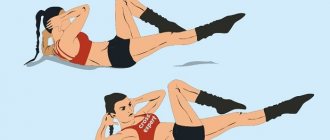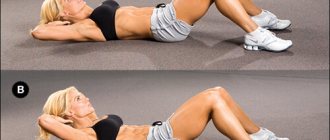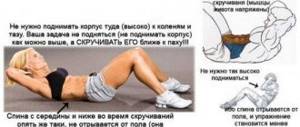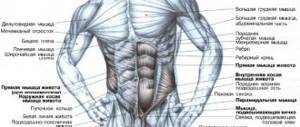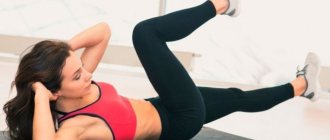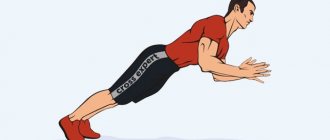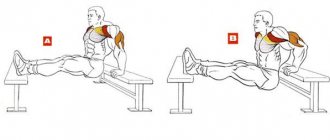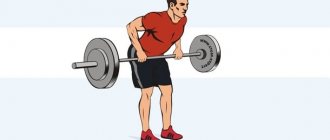Reverse crunches are one of the most effective exercises for pumping up the lower abdominal muscles. The technique of this type of twisting is quite simple and completely accessible to everyone, including beginner athletes. However, to achieve the best results from the training, you need to know some nuances and secrets.
Among the gigantic number of different exercises for working out the abs, one can note only a few truly effective ones, which include twisting, hanging leg raises, and the vacuum exercise. Direct crunches are analyzed in detail in a separate article; in the current article we will talk about reverse abdominal crunches.
Let's look at the mechanics of the exercise's effect on the abdominal muscles, the correct technique and recommendations.
Features of the exercise
The abdominal muscles are formed mainly by a muscle called the rectus abdominis muscle. Its function is to shift (twist) the upper body towards the pelvis and, on the contrary, bring the pelvis towards the upper part of the body. The rectus muscle is a flat muscle that starts from the bottom of the sternum and descends to the lower abdomen. Tendon bridges divide it lengthwise and also crosswise into segments, which form the desired abs. Therefore, it is a complete muscle that does not have a division into upper and lower sections.
Reverse and traditional crunches focus on the same rectus abdominis muscle. Therefore, the opinion that there are separate exercises for the lower abs is erroneous and goes against the basics of physiology and anatomy.
Nevertheless, the upper sections of the rectus abdominis muscle invariably outstrip its lower sections in development. This happens because it is easier for them to get involved in work and get a large and intense load. However, the body strives for the harmonious development of muscle groups; with regular training of the abdominal muscles, following the development of the upper abs, the lower abs will also progress.
Photos of reverse crunches
httpv://www.youtube.com/watch?v=embed/ez-PsVSkWk8
httpv://www.youtube.com/watch?v=embed/I2exweCwDIY
Working muscles
During the exercise the following muscles will be loaded:
- The most important work is performed by the rectus abdominis muscle (especially the lower section).
- Additional muscles involved: iliopsoas muscle, latissimus dorsi, rear deltoid.
- synergists - iliopsoas, oblique muscles, pectineus, sartorius, adductor muscles;
- stabilizer muscles - quadriceps, teres major, rectus femoris, triceps.
Benefits of Exercise
Reverse crunches place maximum stress on the lower rectus abdominis muscle. But, since the abdominal muscles invariably work together (they cannot be isolated), then by doing this exercise, you train your entire abs. Which effectively affects the results of training.
Systematic execution of reverse crunches brings the following effects:
- General development of abdominal muscle strength. Quickly achieve results in the form of a flat, toned stomach.
- Along with the rectus abdominis muscle, the oblique abdominal muscles are actively activated. When combined with a diet aimed at reducing body fat, relief appears (those same cubes).
- Lowest load on the lower back. Compared to traditional crunches, which involve the muscles of the back and hips along with the abdominal muscles, and which can cause discomfort and pain in the lumbar region, this exercise, due to a more isolated load, helps prevent this.
- Improved posture when performing the exercise correctly, the upper back does not round.
However, it is not enough to simply perform a large number of abdominal crunches. If you are overweight and have a poor diet, this will prevent you from seeing any positive changes. In order to give the lower part of the abs relief, it is necessary to reduce the amount of fat deposits in the lower abdomen area. To do this, you will need to keep track of the number of calories you consume and follow a diet. Only in this case will abdominal training produce the expected results.
Execution technique
The exercise can be performed either lying on the floor, using a fitness mat, or using a horizontal bench.
The position of your arms and legs affects the intensity of the load on your abdominal muscles. The farther your heels are from your pelvis, and your palms are further from your head, the harder it is to perform the exercise. The closer the legs are to the pelvis, the easier the twisting. This will allow you to adjust the load level as you progress, gradually making the exercise more difficult.
We will analyze in detail the technique of performing reverse twists.
- First, lie down on a bench or floor. Place your hands along your body or place them behind your head (on a bench - grab its edges near your head with your hands). With your legs bent at the knees, raise your hips to a position perpendicular to the floor.
- Inhale, then as you exhale, with a powerful movement, contract the abdominal muscles, twist your knees towards your chest, as close as possible. Maintain an angle in your knees throughout the entire approach.
- When your legs are at the top point, fix this position for 1 second, feel the greatest contraction of the abdominal muscles and slowly return to the starting position, but do not touch the floor with your feet (tension remains in the abdominal muscles).
- Next, repeat the exercise for the required number of repetitions.
Try to perform the exercise with maximum amplitude. The stronger you contract your abdominal muscles, the more effective the exercise will be, and, accordingly, the better your progress.
The main task in the exercise is not simply lifting the pelvis upward, but actually twisting it towards the head. Once you have mastered the correct execution of crunches, you will feel the work of the rectus abdominis muscle and will be able to purposefully train it.
Focus on the working number of repetitions in the exercise in the region of 10 to 20; you should not perform a huge number of repetitions in crunches. If the exercise is easy for you, then there are more effective ways to increase the load (position of the limbs, additional weight of weights, etc.)
How to “stretch” correctly
During stretching, we work absolutely all muscle groups.
Neck:
- Circular movements of the head clockwise and counterclockwise.
- Tilts the head to the side.
- Tilt the head in different directions with further pressure on it with your hand (performed for 30 seconds).
Back:
- We lie down on our backs. We straighten our arms and move them back. We raise our legs, throw them behind our heads, trying to reach our toes with our toes. We lie in this position for several minutes.
- In a standing position, we cross our arms behind our backs. We begin to lower the body until a right angle is formed with the legs. The back should remain straight.
Hands:
- We make swinging movements with our arms.
- We raise our hands above our heads and fasten them into a lock. In this position, we bend to the sides as deeply as possible.
- We raise one arm and bend it at the elbow. We lower the forearm behind the head, and with the other hand we lightly press on the elbow.
Legs:
- We place our feet shoulder-width apart. We bend over, trying to touch each foot separately.
- We sit on the floor, legs straightened. We pull our heels and toes as far forward as physical fitness allows.
- We sit on a gymnastic mat, spreading our legs as wide as possible. We do bends. We try to bend as deeply as possible, touching each knee with our forehead in turn.
- We take a horizontal position. We lift our legs up and spread them to the side as much as possible. We fixate like this for 40 seconds.
Stomach:
- We lie down on the floor. Legs straightened. We bend our arms at the elbows. Slowly we begin to pull up the chest and shoulder girdle, without lifting the elbows from the surface. We hold this for 15 seconds. Then we slowly lie back on the surface.
- We sit down cross-legged. We raise one hand and place the second on the thigh. We bend to the side with our arms down. We change limbs and repeat again.
Adviсe
A few recommendations for getting maximum results from abdominal crunches:
- Perform the exercise slowly, feeling the tension in your abdominal muscles.
- At the top point of the amplitude, while holding the position for 1 second, you can additionally squeeze (tighten) the abdominal muscles.
- Lower your legs down smoothly, do not do it suddenly. The knees should form a right angle throughout the entire lifting and lowering trajectory.
- Keep your hands on the floor at all times, or hold on to the edges of the bench. If you perform the exercise on the floor, you should not lift them off the floor.
- Watch your lumbar back, press your lower back to the floor and do not allow it to arch.
- Exhalation is done with effort (straining), and inhalation is done with stretching (lowering).
- It is recommended to perform 3-4 approaches, with the number of repetitions, as already mentioned, from 10 to 20.
- Avoid doing oblique crunches by raising your hips to the sides. This position of the body will negatively affect the spine, which may lead to the risk of injury. Twist your pelvis only in a vertical plane.
- Do not lift your head from the bench (floor), you do not need to look at your feet all the time.
You can perform abdominal exercises both before and at the end of the main workout. It is recommended to perform reverse crunches after performing traditional crunches or hanging leg raises on the bar.
Don't make reverse crunches the centerpiece of your ab workout. The development of the abdominal muscles will be more complete as a result of performing several exercises. Following the above tips will help you achieve excellent results in a short time.
Contraindications
There are contraindications to reverse crunches. Which include previous hernias and spinal injuries. In addition, this type of twisting should not be performed during exacerbation of diseases of the gastrointestinal tract, especially ulcers and pancreatitis.
Options:
In addition to the traditional embodiment, the following variations are possible:
- reverse crunches while lying on an incline;
- in a supine position, lying on a fitball, holding the handles of the exercise machine or a bench;
- on the floor with the ball between your legs.
Conclusion
Use reverse abdominal crunches in your abdominal muscle training, this will give them relief and, after a while, achieve the desired abs. Combine this exercise with other abdominal exercises and use methods to increase the intensity of the load.


